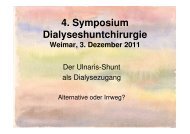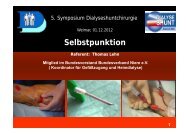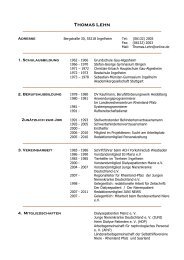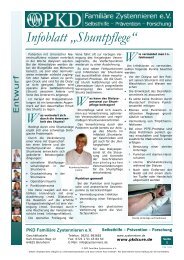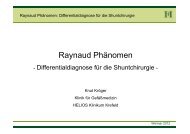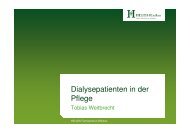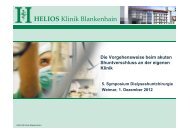2634 K. Konnertechniques like the reverse AV fistula, unusually locatedinterposition grafts and brachio-brachial arterioarterialgrafts[44].The first report on a new angiographic technique,known as digital subtraction angiography waspublished by David L. Ergun (Madison, USA):‘A hybrid computerized fluoroscopy technique<strong>for</strong> noninvasive cardio<strong>vascular</strong> imaging’. Later, thistechnique was adapted to visualize AV fistulas andprosthetic bridge grafts, using the arterial as well as thevenous route [45].Recent ideas1980–1992A highly in<strong>for</strong>mative paper was published by W.P. Geis,together with Dr Giacchino: ‘A game plan <strong>for</strong> <strong>vascular</strong><strong>access</strong> <strong>for</strong> hemodialysis’ – a collection <strong>of</strong> innovative,creative ideas concerning arteriovenous fistulas as wellas graft insertion in various locations [46].The era <strong>of</strong> the percutaneous, transluminal angioplastyin <strong>vascular</strong> <strong>access</strong>es started with a publication<strong>of</strong> David H. Gordon and Sidney Glanz (New York,USA) based on the work <strong>of</strong> Gru¨ntzig: ‘Treatment <strong>of</strong>stenotic lesions in dialysis <strong>access</strong> fistulas and shunts bytransluminal angioplasty’ [47].G. Kro¨nung (Bonn, Germany) published fundamentalideas on how different types <strong>of</strong> cannulation affectedthe remodelling <strong>of</strong> the venous arm <strong>of</strong> the fistula [48].He demonstrated that cannulation may not onlydestroy the vein, but is essential <strong>for</strong> remodelling.Thus, cannulation can be an effective tool to avoidthe <strong>for</strong>mation <strong>of</strong> aneurysms and stenoses.In patients with exhausted vessel anatomy in botharms or stenoses along the subclavian vein resistant tointervention Jose´ R. Polo (Madrid, Spain) introducedthe concept <strong>of</strong> ‘brachial-jugular polytetrafluoroethylenefistulas <strong>for</strong> hemodialysis’ [49], a brilliant solution<strong>for</strong> the occasional patient who may pr<strong>of</strong>it fromcreation <strong>of</strong> a graft-vein-anastomosis using the internaljugular vein.While angiographic and interventional radiologictechniques became widely accepted, non-invasiveultrasound techniques, mainly used by nephrologists,were introduced only slowly. A landmark was thearticle <strong>of</strong> Barbara Nonnast-Daniel (Hannover,Germany) on ‘Colour doppler ultrasound assessment<strong>of</strong> arteriovenous <strong>haemodialysis</strong> fistulas’ [50]. She wasable to obtain anatomic and functional parameters,which were useful to guide the surgeon <strong>for</strong> optimizingthe procedure in the first <strong>access</strong> operation, but alsouseful <strong>for</strong> surveillance and monitoring the function<strong>of</strong> the <strong>access</strong> during follow-up.OutlookThe above remarks reflect the subjective assessment<strong>of</strong> what we consider are the highlights in past ef<strong>for</strong>ts tooptimize the <strong>vascular</strong> <strong>access</strong> in <strong>haemodialysis</strong> patients.Knowledge <strong>of</strong> these ingenious, innovative, sometimeseven bold ideas, although not always successful, isstimulating and hopefully also useful to the physicianstruggling with the challenge to construct <strong>vascular</strong><strong>access</strong>es nowadays. Creative ef<strong>for</strong>ts provided a variety<strong>of</strong> solutions in the past and so, we are happy today toplay on more than one instrument.Vacsular <strong>access</strong> surgery has become an interdisciplinaryfield <strong>of</strong> modern medicine. Once it had beeninaugurated by pioneers in nephrology at a time when<strong>access</strong> surgery was unknown in the then still youngdiscipline <strong>of</strong> <strong>vascular</strong> surgery. In the early 1970s, withthe increasing complexity <strong>of</strong> <strong>access</strong> related problems,nephrologists delegated the responsibilty <strong>for</strong> the<strong>vascular</strong> <strong>access</strong> more and more to their surgeons. Formany years, <strong>vascular</strong> <strong>access</strong> was regarded as anexclusively surgical problem. With the introduction <strong>of</strong>non-invasive preoperative mapping <strong>of</strong> blood vessels, <strong>of</strong>earlier referral to nephrologists and to <strong>access</strong> surgeonsand <strong>of</strong> venous preservation, nephrologists must learnagain to assume responsibility <strong>for</strong> <strong>vascular</strong> <strong>access</strong>.Beyond the preservation <strong>of</strong> vessels in the predialyticphase, this includes surveillance and monitoring <strong>of</strong>the established <strong>access</strong>, but also aquiring up-to-dateknowledge on the surgical options and many otheraspects, but above all maintaining close cooperationwith surgeons and radiologists.What is required today is a completely newapproach to comprehensive <strong>access</strong> management thathas to escape from crisis management. <strong>History</strong> may behelpful.Acknowledgements. I am indebted to Pr<strong>of</strong>. Eberhard Ritz,Heidelberg, Germany <strong>for</strong> insightful comments and review <strong>of</strong> themanuscript. Thanks also to Dr Dirk Hentschel, HavardMedical School, Boston, USA <strong>for</strong> providing the author withFigures 1 and 2.Conflict <strong>of</strong> interest statement. None declared.References1. Jaboulay M, Briau E. Recherches expérimentelles sur la suture etla greffe arte´rielles. Lyon Me´d 1896; 81: 97–992. Carrel A. Technique and remote results <strong>of</strong> <strong>vascular</strong> anastomoses.Surg Gynecol Obstet 1912; 14: 246–2543. Kolff WJ. First clinical experience with the artificial kidney. AnnInt Med 1965; 62: 608–6194. Quinton WE, Dillard DH, Scribner BH. Cannulation <strong>of</strong> bloodvessels <strong>for</strong> prolonged hemodialysis. Trans Am Soc Artif InternOrgans 1960; 6: 104–1135. Scribner BH, Buri R, Caner JEZ, Hegstom R, Burnell JM.The treatment <strong>of</strong> chronic uremia by means <strong>of</strong> intermittenthemodialysis: a preliminary report. Trans Am Soc Artif InternOrgans 1960; 6: 114–1226. Scribner BH. A personalized history <strong>of</strong> chronic hemodialysis.Am J Kidney Dis 1990; 16: 511–5197. Buselmeier TJ, Kjellstrand CM, Simmons RL et al. A totallynew subcutaneous prosthetic arterio-venous shunt. Trans AmSoc Internal Artif Organs 1973; 19: 25–328. Seldinger SI. Catheter replacement <strong>of</strong> the needle in percutaneousarteriography: a new technique. Acta Radiol 1953; 39: 368–376Downloaded from http://ndt.ox<strong>for</strong>djournals.org/ by guest on February 20, 2012
<strong>History</strong> <strong>of</strong> <strong>vascular</strong> <strong>access</strong> <strong>for</strong> <strong>haemodialysis</strong> 26359. Shaldon S, Chiandussi L, Higgs B. Haemodialysis bypercutaneous catheterization <strong>of</strong> the femoral artery and veinwith regional heparinization. Lancet 1961; II: 857–85910. Shaldon S. Percutaneous vessel catheterization <strong>for</strong> hemodialysis.ASAIO J 1994; 40: 17–1911. Cimino, JE, Brescia MJ. Simple venipuncture <strong>for</strong> hemodialysis.N Engl J Med 1962; 267: 608–60912. Fogarty TJ, Cranley JJ, Krause RJ, Strasser ES, Hafner CD.A method <strong>for</strong> extraction <strong>of</strong> arterial emboli and thrombi.Surg Gynecol Obstet 1963; 116: 24113. Brescia MJ, Cimino JE, Appel K, Hurwich BJ. Chronichemodialysis using venipuncture and a surgically createdarteriovenous fistula. N Engl J Med 1966; 275: 1089–109214. Cimino JE, Brescia MJ. The early development <strong>of</strong> thearteriovenous fistula needle technique <strong>for</strong> hemodialysis.ASAIO J 1994; 40: 923–92715. Sperling M, Kleinschmidt W, Wilhelm A, Heidland A,Klütsch K. Die subkutane arterioveno¨se Fistel zur intermittierendenHämodialyse-Behandlung. Dtsch Med Wschr 1967;92: 425–42616. Dotter CT, Judkins MP, Ro¨sch J. Nonoperative treatment <strong>of</strong>arterial occlusive disease. A radiologically facilitated technique.Radiol Clin N Am 1967; 5: 531–54217. Röhl L, Franz HE, Mo¨hring K et al. Direct arteriovenousfistula <strong>for</strong> hemodialysis. Scand J Urol Nephrol 1968; 2: 191–19518. Aubaniac R. Une nouvelle voie d’injection ou de ponctionveineuse: la voie sous-claviculaire. Sem Hop Paris 1952; 28:3445–344719. Erben J, Kvasnicka J, Bastecky J, Vortel V. Experience withroutine use <strong>of</strong> sucblavian vein cannulation in <strong>haemodialysis</strong>.Proc EDTA 1969; 6: 59–6420. Schillinger F, Schillinger D, Montagnac R, Milcent T. Postcatheterization vein stenosis in <strong>haemodialysis</strong>: comparativeangiographic study <strong>of</strong> 50 subclavian and 50 internal jugular<strong>access</strong>es. Nephrol Dial Transplant 1991; 6: 722–72421. Thomas GI. A large vessel applique A-V-shunt <strong>for</strong> hemodialysis.Trans Am Soc Artif Intern Organs 1969; 15: 288–29222. Coronel F, Herrero JA, Mateos P, Illescas ML, Torrente J,del Valle MJ. Long-term experience with the Thomas shunt,the <strong>for</strong>gotten permanent <strong>vascular</strong> <strong>access</strong> <strong>for</strong> <strong>haemodialysis</strong>.Nephrol Dial Transplant 2001; 16: 1845–184923. Flores-Izquierdo G, Vivero RR, Exaire E, Chavez AH,de los Rios JG. Autoinjerto venoso para hemodialysis(Tecnica original). Arch Inst Cardiol Mex 1969; 39: 259–26624. May J, Tiller D, Johnson J, Stewart J, Sheil AGR. Saphenousveinarteriovenous fistula in regular dialysis treatment. N Engl JMed 1969; 280: 77025. Girardet RE, Hackett RE, Goodwin NJ, Friedman EA.Thirteen months experience with the saphenous vein graftarteriovenous fistula <strong>for</strong> maintenance hemodialysis. Trans AmSoc Artif Intern Organs 1970; 16: 285–29126. Brittinger WD, Strauch M, Huber W et al. 16 monthsexperience with the subcutaneously fixed superficial femoralartery <strong>for</strong> chronic <strong>haemodialysis</strong>. Proc EDTA 1970; 7: 408–41227. Sparks CH. Die-grown rein<strong>for</strong>ced arterial grafts: observationson long-term animal grafts and clinical experience. Ann Surg1970; 172: 787–79428. Beemer RK, Hayes J. Hemodialysis using a mandril-growngraft. Trans Am Soc Artif Intern Organs 1973; 19: 43–4829. Capodicasa G, Perna N, Giordano C. Is a shunt anindispensable requirement <strong>for</strong> repeated <strong>haemodialysis</strong>?Proc EDTA 1971; 8: 517–52030. Brittinger W-D, von Henning GE, Twittenh<strong>of</strong>f W-D et al.Implantation <strong>of</strong> a plastic valve into the superficialised femoralartery. Proc EDTA 1971; 8: 521–52531. Chinitz JL, Yokoyama T, Bower R, Swartz C. Self-sealingprosthesis <strong>for</strong> arteriovenous fistula in man. Trans Am Soc ArtifIntern Organs 1972; 18: 452–45532. Soyer T, Lempinen M, Cooper P, Norton L, Eiseman B. A newvenous prosthesis. Surgery 1972; 72: 864–87233. Baker LD Jr, Johnson JM, Goldfarb D. Expanded polytetrafluoroethylene(PTFE) subcutaneous arteriovenous conduit:an improved <strong>vascular</strong> <strong>access</strong> <strong>for</strong> chronic hemodialysis. TransAm Soc Artif Intern Organs 1976; 22: 382–38734. Dunn I, Frumkin E, Forte R, Raquena R, Levowitz BS.Dacron velour <strong>vascular</strong> prosthesis <strong>for</strong> hemodialysis. Proc ClinDial Transplant Forum 1972; 2: 8535. Staple TW. Retrograde venography <strong>of</strong> subcutaneous arteriovenousfistulas created surgically <strong>for</strong> hemodialysis. Radiology1973; 106: 223–22436. Thelen M, Frotscher U, Frommhold H, Kozuschek W.Angiographische Darstellung von arterioveno¨sen <strong>Shunt</strong>s beiDialysepatienten. Fortschr Roentgenstr 1972; 117: 438–44437. Grüntzig A, Bollinger A, Brunner U, Schlumpf M, Wellauer J.Perkutane Rekanalisation chronischer arterieller Verschlu¨ssenach Dotter — eine nicht-operative Kathetertechnik. SchweizMed Wschr 1973; 103: 825–83138. Mindich BP, Levowitz BS. Human umbilical cord vein fistula.A novel approach <strong>for</strong> hemodialysis. Dial Transplant 1976; 5:19–8739. Dardik H, Ibrahim IM, Dardik I. Arteriovenous fistulasconstructed with modified human umbilical cord vein graft.Arch Surg 1976; 111: 60–6240. Gracz KC, Ing TS, Soung L-S, Armbruster KFW, Seim SK,Merkel FK. Proximal <strong>for</strong>earm fistula <strong>for</strong> maintenancehemodialysis. Kidney Int 1977; 11: 71–7441. Konner K. Primary <strong>vascular</strong> <strong>access</strong> in diabetic patients: anaudit. Nephrol Dial Transplant 2000; 15: 1317–132542. Golding AL, Nissenson AR, Raible D. Carbon transcutaneous<strong>access</strong> device (CTAD). Proc Dial Transplant Forum 1979; 9:242–24743. Shapiro FL, Keshaviah P, Carlson LD et al. Blood <strong>access</strong>without percutaneous punctures. Proc Dial Transplant Forum1980; 10: 130–13744. Giacchino JL, Geis WP, Buckingham JM, Vertuno LL,Bansal VK. Vascular <strong>access</strong>: long-term results, new techniques.Arch Surg 1979; 114: 403–40945. Ergun DL, Mistretta CA, Kruger RA, Riederer SJ, Shaw CG,Carbone DP. A hybrid computerized fluoroscopy technique <strong>for</strong>noninvasive cardio<strong>vascular</strong> imaging. Radiology 1979; 132:739–74246. Geis WP, Giacchino JL. A game plan <strong>for</strong> <strong>vascular</strong> <strong>access</strong> <strong>for</strong>hemodialysis. Surg Rounds 1980; 62–7047. Gordon DH, Glanz S, Butt KMH, Adamsons RJ, Koenig MA.Treatment <strong>of</strong> stenotic lesions in dialysis <strong>access</strong> fistulas andshunts by transluminal angioplasty. Radiology 1982; 143: 53–5848. Krönung G. Plastic de<strong>for</strong>mation <strong>of</strong> Cimino fistula by repeatedpuncture. Dial Transplant 1984; 13: 635–63849. Polo JR, Sanabia J, Garcia-Sabrido JL, Luno J, Menarguez C,Echenagusia A. Brachial-jugular polytetrafluoroethylene fistulas<strong>for</strong> hemodialysis. Am J Kidney Dis 1990; 16: 465–46850. Nonnast-Daniel B, Martin RP, Lindert O et al. Colour dopplerultrasound assessment <strong>of</strong> arteriovenous <strong>haemodialysis</strong> fistulas.Lancet 1992; 339: 143–145Downloaded from http://ndt.ox<strong>for</strong>djournals.org/ by guest on February 20, 2012



